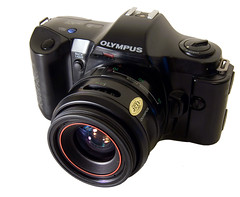Difference between revisions of "Olympus OM-101 / OM-88"
Rebollo fr (talk | contribs) m (markup change and moved a sentence) |
Timmy Toucan (talk | contribs) m |
||
| Line 8: | Line 8: | ||
The body only has a program exposure mode; no program shift or shutter speed information is displayed at all (unlike the [[Olympus OM-707|OM-707]] which at least shows the shutter speed/program shift when using AF OM lenses in AF mode). With manual focus OM lenses, the body operates in aperture priority auto exposure mode, again with no information displayed about the settings used. | The body only has a program exposure mode; no program shift or shutter speed information is displayed at all (unlike the [[Olympus OM-707|OM-707]] which at least shows the shutter speed/program shift when using AF OM lenses in AF mode). With manual focus OM lenses, the body operates in aperture priority auto exposure mode, again with no information displayed about the settings used. | ||
| − | Along with a dearth of information about the camera's chosen settings, there is a shortage of manual controls: apart from the shutter release and the Mode/Power switch, the camera features only a 'Backlight' button (which makes no visible difference to the user when pushed) and a 'self-timer' button. To have more | + | Along with a dearth of information about the camera's chosen settings, there is a shortage of manual controls: apart from the shutter release and the Mode/Power switch, the camera features only a 'Backlight' button (which makes no visible difference to the user when pushed) and a 'self-timer' button. To have more control, you needed to attach an accessory called '''Manual Adapter 2''', allowing manual exposure and aperture priority modes with all lenses. |
| − | The camera's only smart interface component is the Power Focus wheel | + | The camera's only smart interface component is the Power Focus wheel which is fast, responsive and intuitive. Unlike the [[Olympus OM-707|OM-707]] which also offers PF (with a less user-friendly sliding switch), the OM-101 features a split-image viewfinder, making Power Focus quick and accurate. |
== Links == | == Links == | ||
Revision as of 06:30, 12 December 2006
The Olympus OM-101 was a single lens reflex released in 1988 by Olympus, which takes Olympus OM lenses. It was called OM-88 on some markets.
After the unsuccessful autofocus SLR OM-707, the OM-101 was a simpler model aimed at the amateur market, which could take the autofocus lenses but only had an electric focusing command with no autofocus. There were even two lenses released without any focusing ring or autofocus capacity - only compatible with the OM-101 and labelled 'PF' for PowerFocus. These were the 50mm/F2 PF and 35-70mm/F3.5-4.5 PF.
The body only has a program exposure mode; no program shift or shutter speed information is displayed at all (unlike the OM-707 which at least shows the shutter speed/program shift when using AF OM lenses in AF mode). With manual focus OM lenses, the body operates in aperture priority auto exposure mode, again with no information displayed about the settings used.
Along with a dearth of information about the camera's chosen settings, there is a shortage of manual controls: apart from the shutter release and the Mode/Power switch, the camera features only a 'Backlight' button (which makes no visible difference to the user when pushed) and a 'self-timer' button. To have more control, you needed to attach an accessory called Manual Adapter 2, allowing manual exposure and aperture priority modes with all lenses.
The camera's only smart interface component is the Power Focus wheel which is fast, responsive and intuitive. Unlike the OM-707 which also offers PF (with a less user-friendly sliding switch), the OM-101 features a split-image viewfinder, making Power Focus quick and accurate.
Links
- 'The Unofficial Olympus Sales Information File' page about the OM-101
- OM-101 manual (.pdf) from olympus.com
In Japanese:
